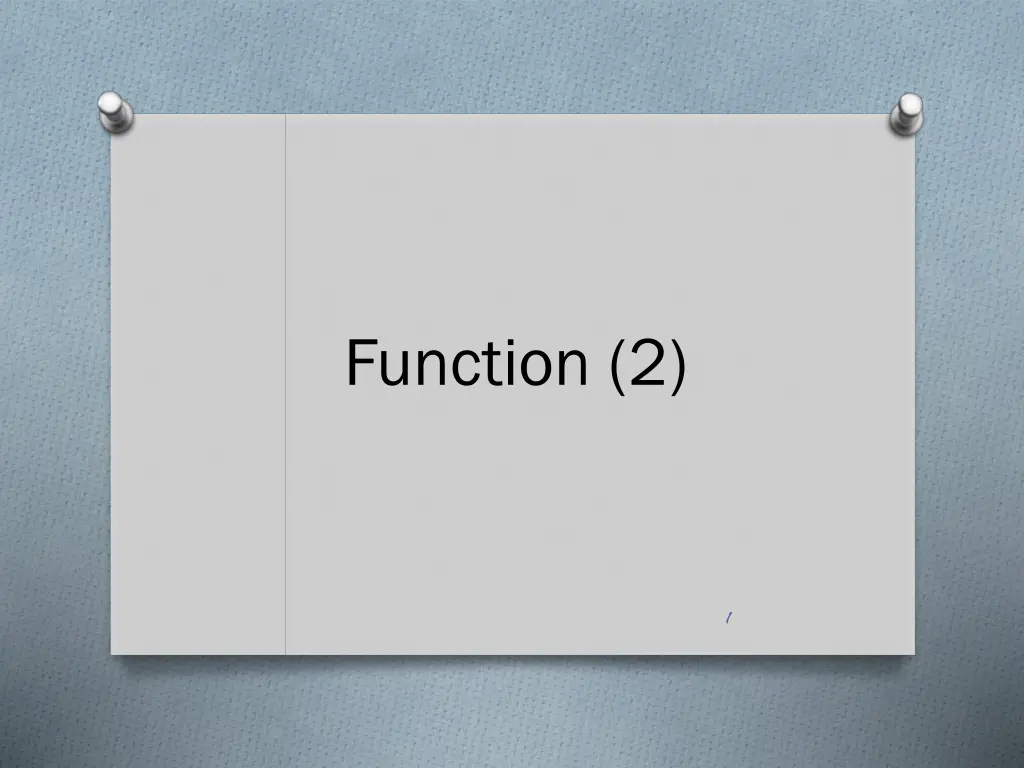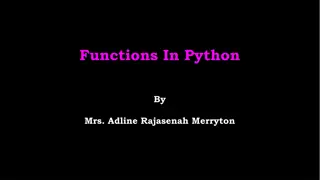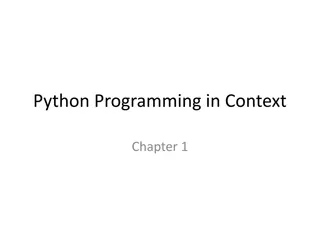
Understanding Python Function Parameters and Default Values
Learn about Python function parameters, arguments, default values, and mutable vs. immutable objects in this comprehensive guide. Discover how to define parameters, pass arguments, set default values, and work with different types of objects in Python functions.
Download Presentation

Please find below an Image/Link to download the presentation.
The content on the website is provided AS IS for your information and personal use only. It may not be sold, licensed, or shared on other websites without obtaining consent from the author. If you encounter any issues during the download, it is possible that the publisher has removed the file from their server.
You are allowed to download the files provided on this website for personal or commercial use, subject to the condition that they are used lawfully. All files are the property of their respective owners.
The content on the website is provided AS IS for your information and personal use only. It may not be sold, licensed, or shared on other websites without obtaining consent from the author.
E N D
Presentation Transcript
Objectives O This chapter introduces: 1. Arguments & parameters Immutable and mutable objects Return data in a function Call the function 2. 3. 4. 2
Arguments & parameters O A parameter is the variable listed inside the parentheses in the function definition O You can add as many parameters as you want, just separate them with a comma O An argument is the value that is sent to the function when it is called O Information can be passed into functions as arguments def person(name, age, gender): print('Name: ' + name, end = ', ') print('age: ' + str(age), end = ', ') print('gender: ' + gender) person('John', 25, 'Male') person('Sandy', 32, 'Female') 3
Default parameter value O The parameters of a function can use default values O If we call a function without argument, it can use the default value def person(name = 'Andy', age = 18, gender = 'Male'): print('Name: ' + name, end = ', ') print('age: ' + str(age), end = ', ') print('gender: ' + gender) person() # Name: Andy, age: 18, gender: Male person('John', 25, 'Male') # Name: John, age: 25, gender: Male 4
Default parameter value def person(name = 'Andy', age = 18, gender = 'Male'): print('Name: ' + name, end = ', ') print('age: ' + str(age), end = ', ') print('gender: ' + gender) person() person('Bob') person('Maria', 'Female') # The arguments will be carried into the function in order person('Maria', gender = 'Female') # Parameter can be specified when calling the function 5
Immutable and mutable objects O There are two kinds of objects in Python O Mutable Object O list, dict, set, byte array, user-defined classes O The value of a mutable object can be modified in place after it s creation O Immutable Object O int, float, long, complex, string tuple, bool O The value of an immutable object cannot be changed O When we attempt to modify an immutable object, Python simply gives us a different object instead 6
Immutable objects a = 5 #id(obj): Get the memory address print( a + hex(id(a))) print() a += 3 print('a ' + hex(id(a))) print() b = a print('a ' + hex(id(b))) print('b ' + hex(id(b))) print() b += 5 print('a ' + hex(id(a))) print('b ' + hex(id(b))) Output result: a += 3: a s address is changed b = a: the addresses of a and b are the same b += 5: the address of b is changed 7
Mutable objects O The value of a mutable object can be directly modified O After the value is modified, the memory address of the object will be the same as before O If two variables refer to the same mutable object through a process called aliasing (assign one variable the value of the other variable) O The value of one variable is changed as well as that of the other variable 8
Mutable objects a = [0, 0] b = a print('a ' + hex(id(a))) print('b ' + hex(id(b))) print() b[0] += 1 b.append(2) print('a ' + hex(id(a))) print('b ' + hex(id(b))) print() print(a) print(b) Have the same address after changing the value, The values of a and b are the same 9
Immutable and mutable objects O Argument of a function can be an immutable object or a mutable object def add_number(num): num += 1 print(num) def add_number(num): num[0] += 1 print(num[0], num[1]) a = 0 add_number(a) print(a) b = [0, 0] add_number(b) print(b[0], b[1]) 10
Return data O Use the return keyword in the function to return the result of the function def add(a, b ,c): d = a+b+c return d print(add(3, 4, 14)) # add(3, 4, 14) = 21 # print(add(3, 4, 14)) = print(21) 11
Call a function O In a function, it allows to call itself or another function O Recursive function O A defined function can call itself O Recursion is a common programming concept O The developer should be very careful with recursion as it can be quite easy to slip into writing a function which never terminates, or one that uses excess amounts of memory or processor power O When written correctly recursion can be a very efficient and mathematically-elegant approach to programming mathematical and 12
Example def max2(a, b): if(a > b): return a else: return b def max3(a, b, c): # Find the largest one of the three numbers d = max2(a, b) # Call another function return max2(c, d) print(max2(5,3)) print(max3(20,15,36)) 13
Example factorial(3) O Recursive function: Return 6 def factorial(n): # Calculate the factorial value if n == 1: return 1 else: return n * factorial(n-1) 3 * factorial(2) Return 2 2 * factorial(1) Return 1 while 1: n = int(input( Enter a positive integer: ')) print(str(n) + '! = ' + str(factorial(n))) 14
Source O References: O https://docs.python.org/3/library/functions. html O https://docs.python.org/3/reference/datamo del.html O Python 15
Exercise 1 O Write a Python function that will repeatedly ask the user to input a positive number N, until the inputted value is not positive. When N is inputted, print a list whose elements are square of numbers between 1 and N (include 1 and N). O Input: 20 0 O Output: [1, 4, 9, 16, 25, 36, 49, 64, 81, 100, 121, 144, 169, 196, 225, 256, 289, 324, 361, 400] bye 16
Exercise 2 O Write a program that will load data from input.txt and list all permutations for the unique data in input.txt O Input: Output: 17






















